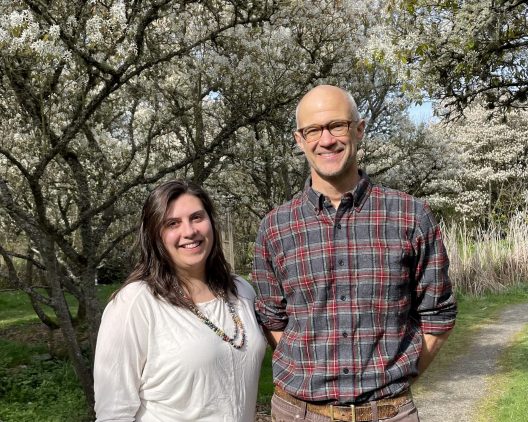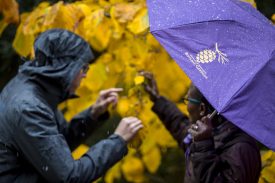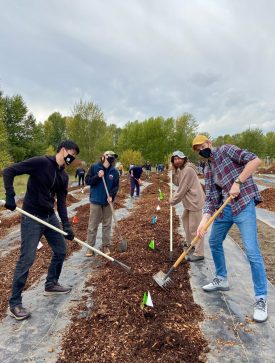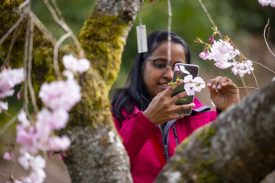A Vibrant, Welcoming and Diverse Future for UW Botanic Gardens: UWBG’s Co-Directors in Conversation

A recent leadership transformation is propelling the University of Washington Botanic Gardens (UWBG) into the future: for the first time, the organization is being guided by not one, but two directors.
This change was made by Dan Brown, director of the UW School of Environmental and Forest Sciences (SEFS), after he determined that the breadth of the directorship’s responsibilities would best be fulfilled by two people. So, last September, Christina Owen was named the director and Josh Lawler the faculty director.
The position is a homecoming of sorts for Owen, who earned her Ph.D. in the Evolutionary Genetics of Flowering Plants from UW in 2009. As director, she provides overall leadership for UWBG programs, facilities and staff, with a keen emphasis on bolstering the organizational and community partnerships central to the organization’s work, health and relevance.
She previously served for 11 years as a program officer with the Bill & Melinda Gates Foundation. There, she developed and managed grants in research and development, with a focus on addressing pest and disease threats to crop production in low-income countries.
Lawler, a professor at SEFS since 2007, specializes in climate change impacts, conservation science, landscape ecology, nature-human interactions and wildlife science. He has led the Center for Creative Conservation and is currently director of the University’s Nature and Health Initiative, a program of Earthlab. His directorship responsibilities include supporting and advancing research and teaching programs at the undergraduate and graduate levels.
Below is an edited version of a recent conversation about their first six months of leadership, including their goals for UWBG’s future.
Clare McLean (CM): Good morning! Let’s jump right in. What led to the change to two directors?
Josh Lawler (JL): In the past there had been a single director who was in charge of everything: the academic programs, the public programming, the grounds, fundraising, the whole operation. It was a very demanding position–it required that somebody have the ability to get tenure and run UWBG. It was fairly unrealistic, I think. We could have found somebody if we looked forever, but we didn’t have forever. So Dan Brown decided to split the position in two and have one person be the academic director and one person be the director.
Christina Owen (CO): I think of my role as being the managing director because I manage all the operations, staff and the day-to-day stuff of the Botanic Gardens. When you include our temporary and hourly staff, that’s a total of 91 employees.
JL: We have fairly different purviews, mine being much narrower than Christina’s. There are currently only three faculty (including me) and roughly ten graduate students at the Center for Urban Horticulture (CUH). That should change in the near future. We have plans for bringing in a group of students and faculty who are exploring relationships between nature and human health. And we’re working on a proposal to develop a graduate program in that area.
CM: Has the perception of parks and public gardens shifted due to the pandemic?
CO: I don’t think you would have to look too hard to find people who would say that public greenspaces and parks saved their lives in the pandemic. When you’re stuck at home and you’re dealing with such a high level of stress, being in a greenspace is one of those solaces that you have. It’s one of the places to find peace in a world that feels so crazy. Josh, this is right up your alley with your interest in nature and health impacts.
JL: Yes, many papers have come out since 2020 demonstrating that people’s use of parks and green space is increasing. There are many more studies that demonstrate how time spent in nature can positively affect mental health–reducing stress, anxiety, rumination, and depression. So there’s scientific evidence that there are real benefits–it’s not just anecdotal evidence.
CM: Christina, what’s your vision for UWBG in five years?

CO: The Arboretum is over 230 acres and it is absolutely a public space. And when we say public that means everyone, not just the people that live close by.
The Arboretum Foundation has been working with us to fundraise for an assessment for visitors and the community to ask questions about who’s visiting and where they’re from. And who’s not visiting and why not–what are the barriers? And what do people want in their parks and in this space specifically?
I’m thinking about how to connect the great work that’s happening on the academic side with the community–and not just through education, but through pleasure and service. I think we can take the expertise of the university and make a direct impact on many diverse communities in the city. I want to see the Arboretum and the Botanic Gardens be that vibrant place where people come because they love it, because it’s pleasurable and they find joy and peace there. And then they can walk away with some knowledge or a way to connect deeper with what they’re interested in.
CM: Josh, what’s your vision for UWBG in the academic realm?

JL: My vision is for UWBG to be a living laboratory for studies in sustainable agriculture, climate adaptation, urban farming, and ecopsychology. I see it as a place where people can go to experience some of those things in action, but also a place where students and faculty can go to produce the knowledge that advances our understanding of those fields.
Our faculty and academic programs should be constantly evolving to meet societal needs and the needs for today’s–and tomorrow’s–students. When faculty retire and new faculty are hired, a department needs to step back and ask what disciplines, what areas of research, what classes are really needed. SEFS went through a visioning and planning process not too long ago and climate adaptation was one of the major topics highlighted. In previous searches the intersection between nature and health, eco-hydrology, and forest ecosystem services were highlighted as areas in which the school needed to grow to offer our students and society the kind of research and classes they need for the future.
CM: It sounds like you’re actively incorporating the University’s diversity, equity and inclusion (DEI) initiatives and values into the work you’re doing.
CO: A key priority for me this year is to integrate all of those values into what we do and how we do it. So one of the first things we’ve done is have everyone in our senior management team take the DEI rubric that the university has provided and score ourselves.
There’s some low-hanging fruit that we’ll tackle right away, in terms of providing more structure for onboarding, offboarding, and working on the culture stuff. I’m looking at including diversity, equity and inclusion performance goals for all senior management team members.
And in order to diversify our workforce, we need to be able to have the right processes in place to have a diverse candidate pool and to be able to hire diverse candidates. And we need to make sure that the environment and the culture we’re creating here is welcoming and respectful to everyone.
JL: Everything Christina said applies to faculty and students. I sit on the DEI committee for SEFS and we spent last year coming up with a DEI plan. Recruiting and retaining a diverse student body will also require recruiting and retaining a faculty that is more representative of that student body who can serve as role models and mentors.
CM: Josh, what are some concrete actions that will help reach these diversity goals?
JL: For students, this means creating spaces where they’re comfortable and feel supported. In SEFS, we recently created a physical space for BIPOC students and students from other underrepresented groups. We recently removed some of the barriers in the graduate application process. And this year we offered multiple fellowships aimed at recruiting more graduate students from underrepresented groups.
We’re currently in the process of hiring three new faculty to SEFS. This is, to my knowledge, the first time that diversity and equity have been forefront in a SEFS faculty search. All that said, there is much more that needs to be done to make students and faculty from underrepresented groups feel more welcome.
CM: How does UWBG fit into the larger University?
CO: Objectively speaking–as much as I can be objective–UWBG really fulfills the university’s mission for public outreach and connecting to the public for the public benefit. We sit in that niche. We interact with the public a lot more than most other departments do.
We recently had the pleasure of hosting our new dean [Maya Tolstoy, the Maggie Walker Dean of the College of the Environment]. She communicated to us that she sees the Arboretum and the functions of UWBG as an asset to the college and one that she really values.
CM: There’s been a consistent concern over UWBG’s lifetime about the lack of sufficient funding for both staff and facilities. Christina, fundraising and revenue generation are under your purview, so what are your thoughts about how funding could be enhanced?

CO: I’ve been thinking a lot about how UWBG provides services to the state, the city and the county, but I don’t know that we’re fully financially supported for all that work we do. You know, we maintain the only seed bank for native plants in the state in the Miller Seed Vault. And then we have the Washington State Noxious Weed Board’s type specimens in the Herbarium.
Our green spaces support health in our state, in our county, in our city–we’re an asset. So I’m thinking about ways that we could leverage that to see some more support from our government on many levels.
CM: Before we wrap up, are there any other thoughts you’d like to share?
JL: I’m hoping we’ll be able to more directly engage the public in research at UWBG. That could be through eco-psychology experiments to explore the mental health benefits of forest bathing, gardening, or bird watching, through participation in new courses in urban agriculture, or as volunteers for a new migratory bird banding station.
CO: There’s a huge opportunity with the Arboretum’s North Entry when WSDOT finishes up the SR520 project, probably in the late 20s. There’s about 28 acres that will come back to the Arboretum and UWBG management. Thinking about that land is just so profound for me. I’ve started asking questions around: Whose voices are at the table? How do we honor the people that were on that land first? How do we make sure that we’re reaching out and gathering those voices before any decisions get made about what happens with that land?
One of the projects we’ve been talking about at the Arboretum would be in the Woodland Meadow just south of the greenhouse. We’re looking at actively fundraising to shift that into a community gathering space where we can have concerts or performances or events. I want to see a lot more of those kinds of things happening. That way we can get a broader diversity of visitors because we are providing a broader diversity of experiences and opportunities. I really see these things threading and braiding together to create something beautiful.
CM: Thank you so much for your time and for sharing your visions for the future!